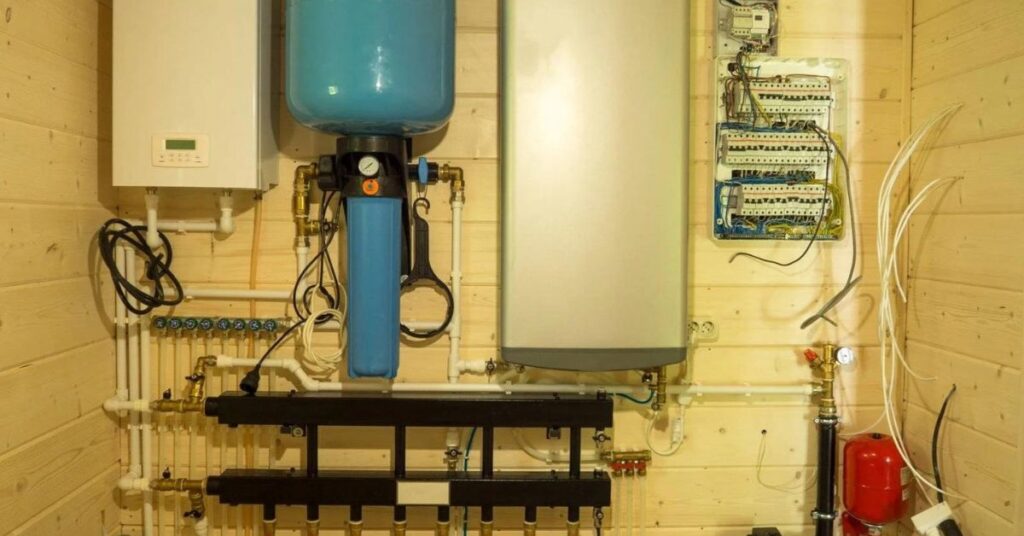Incorporating a water heater expansion tank is a highly effective strategy for optimizing the efficiency and durability of your water heater. The expansion tank helps mitigate pressure on your plumbing and water heater by storing excess water generated during the heating process. In turn, this ensures a smooth hot water supply throughout your home. Therefore, this post will show you how to install a water heater expansion tank. Let’s get started.
Why Install a Water Heater Expansion Tank?
Maintaining the optimal performance and extending the lifespan of your water heater requires installing an expansion tank. The following are the reasons why this addition is crucial:
Pressure Regulation
Expansion tanks serve as pressure regulators by accommodating excess water volume generated during heating. It minimizes the risk of leaks, bursts, and other pressure-related problems associated with the water heater and plumbing.
Prevention of Thermal Expansion
When water heats up, it expands. Thermal expansion without an expansion tank can cause increased pressure within the water heater, causing damage over time. The expansion tank allows the heated water to expand safely as a buffer.
Extended Appliance Lifespan
As a result of reducing stress on the water heater, an expansion tank contributes to its longer lifespan. An efficient and durable system has fewer pressure fluctuations and minimal wear and tear on its components.
Consistent Hot Water Supply
Your water heater will run more consistently if you install an expansion tank. Regulated pressure ensures a steady and uninterrupted hot water supply throughout your home.
Compliance with Plumbing Codes
Building codes require the installation of expansion tanks in many regions like Dallas, Texas. Ensure compliance meets regulatory standards and protects your property from water damage.
This proactive measure ensures system integrity, promotes energy efficiency, and ensures a reliable hot water supply, ultimately safeguarding your investment.
How to Install Water Heater Expansion Tank
The following is the step-by-step guide to installing a water heater expansion tank.
Gather the Necessary Tools and Materials
Gathering all your tools and materials before you install your water heater expansion tank is crucial. It ensures a seamless and efficient installation experience. Here’s a comprehensive list to help you prepare:
Tools
- Adjustable wrench
- Pipe wrench
- Pipe thread sealant or plumber’s tape
- Tubing cutter or hacksaw
- Teflon tape
- Pressure gauge
- Screwdriver
- Bucket or towels for potential water spillage
Materials
- Water heater expansion tank kit (includes the tank, necessary fittings, and installation instructions)
- Copper or flexible water supply lines
- Pipe fittings (if not included in the expansion tank kit)
- Compression fittings
- Pipe straps or brackets for securing the expansion tank
- Pipe insulation (optional for added energy efficiency)
- Safety goggles and gloves
Turn Off the Power and Water Supply
Turn off the power and water supply before installing your water heater expansion tank. Locate and turn off the corresponding circuit breaker if you have an electric water heater. Set the gas control valve to “pilot” for gas heaters and shut off the gas supply.
Turn the cold water inlet valve clockwise near the top of the heater to stop water flow. Drain some water from the tank using the drain valve for added safety. Before installing, ensure these steps are followed to ensure a safe working environment.
Identify the Location for Installation
Choosing the right location for your water heater expansion tank is key. You should put the expansion tank near the water heater’s cold-water supply line. Ensure it is easily accessible for future maintenance.
Depending on the manufacturer’s recommendations and space, you can mount it horizontally or vertically. Keep enough distance from the water heater for proper installation. Choosing the right location ensures the expansion tank functions effectively and alleviates pressure within your water heating system.
Check the Pressure Setting
Before installing your water heater expansion tank, ensure your water heater’s pressure setting is correct. This step ensures compatibility between the expansion tank and the existing system. Using a pressure gauge, measure the water pressure inside the tank.
It should match the water heater’s pressure rating. You might need to make adjustments, so check the manufacturer’s instructions. Confirming your water heater’s pressure setting during installation is crucial to ensure seamless operation and longevity.
Install the Expansion Tank
It’s time to install your water heater expansion tank. Position the tank in the chosen location, aligning it with the cold-water supply line. Follow the manufacturer’s guidelines when securing the tank with brackets or straps. Using the provided fittings, connect the expansion tank to the water heater. Employ Teflon tape or pipe thread sealant to prevent leaks.
Tighten all connections with an adjustable wrench to ensure a snug fit. The expansion tank’s effectiveness depends on precise mounting and connections. Taking this step will improve the performance and durability of your water heater.
Connect the Pipes
After installing your water heater expansion tank, it is time to connect the pipes. Connect the cold-water supply line to the expansion tank’s designated inlet. Use the appropriate fittings to secure a tight connection, preventing leaks. Then, extend the hot water outlet from the water heater to the outlet on the expansion tank.
Don’t forget to double-check all plumbing connections to ensure they’re secure. The use of compression fittings and Teflon tape provides a leak-free integration. Your water heating system will be seamlessly integrated with this meticulous approach to pipe connections.
Adjust the Air Pressure
It’s crucial to fine-tune the air pressure inside your water heater expansion tank. Utilize a tire pressure gauge to measure the current air pressure. Ensure the pressure is within the heater’s recommended range, typically 40-60 psi. There’s usually a valve on expansion tanks, so you can adjust it easily.
Follow the manufacturer’s guidelines to achieve the precise pressure setting. The correct air pressure ensures the expansion tank works appropriately, maintaining the balance between thermal expansion and system pressure. The overall efficiency and longevity of your water heater depend on this step.
Turn On the Power and Check for Leaks
Turn on the circuit breaker or set the gas control valve to the desired temperature as the installation nears completion. Turn on the water supply to the heater. Keep an eye out for leaks around the expansion tank. Fix any issues right away by tightening fittings or adding sealant. This final step ensures a smooth transition to an upgraded water heating system, providing reliable and efficient hot water.
Hire a Professional for Reliable Installation
This guide offers comprehensive instructions on installing a water heater expansion tank, but plumbing tasks can be tricky, especially in a city like Dallas. In case you’re unsure or uncomfortable with any step, a professional plumber in Dallas can help. Licensed plumbers are familiar with local regulations and ensure adherence to Dallas building codes, reducing error risks.
With their experience, they can handle unforeseen challenges in Dallas, Texas, and make sure your installation is secure. It streamlines the process and ensures a durable and reliable installation well-suited to Dallas.
Read More: How to Research Your Water Heater Specialist
Conclusion
Follow this step-by-step guide to improve the efficiency and longevity of your water heating system. It’s crucial to keep your hot water supply consistent while preventing problems. Whenever in doubt, ask a professional plumber for any signs of wear. Ultimately, your new expansion tank ensures reliable and efficient water heating, ensuring comfort and peace of mind.


